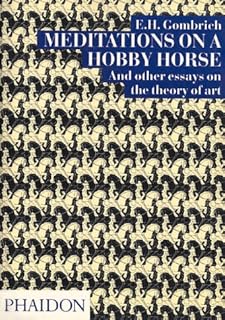
《建築評論論文集-現代建築與歷史變遷》田園城市│施植明, Alan Colquho│1998
頁48 著名論文 Meditation on a Hobby Horse 翻譯錯誤
這是E. H.. Gombrich 的一篇很有名的論文有數種漢譯通常文"木馬沉思記"而不是詩先生所譯的"對癖好的沉思"因為原作者文中很明白指出.....參考"Deridada" ,dada, hobby horse
Meditations On a Hobby Horse and Other Essays On the Theory of Art [Paperback] E.H. Gombrich (Author)
![]() Originally published in 1963, this book was the first volume to be published in the author's long and distinguished series of collected essays. In it he addresses fundamental questions about the nature of artistic achievement, the criteria of artistic value, and the role of language in understanding and interpreting images. These essays explore the problematic character of metaphors, analogies, symbols, myths, conventions and traditions in art and art-historical writing, and investigate the notions of representation, expression, abstraction and illusion.
Originally published in 1963, this book was the first volume to be published in the author's long and distinguished series of collected essays. In it he addresses fundamental questions about the nature of artistic achievement, the criteria of artistic value, and the role of language in understanding and interpreting images. These essays explore the problematic character of metaphors, analogies, symbols, myths, conventions and traditions in art and art-historical writing, and investigate the notions of representation, expression, abstraction and illusion.
----
内容简介 · · · · · ·
從作者在本書的論述,可見他的思維深受60年代西方思想的顯學結構主義所影響:利用相互對照的方式,呈現兩者的差異,進而探究其隱含的文化含義。此書的論述非時下流行樣式的泛泛之論,剖析與建築文化相關的議題皆發人深省,期望國內建築評論朝向更專業與學術的方向發展。
作者简介 · · · · · ·
Alan Colquhoun於1921年在英國出生。1949年在倫敦建築學院取得建築學位。1978年他所撰寫的《現代建築與歷史變遷︰1962-1976論文 集》由Gustavo Gill出版社發行。曾在母校倫敦大學建築學院、倫敦中央理工學院擔任教職,目前為普林斯頓大學建築學院教授。Essays in Architectural Criticism
Modern Architecture and Historical Change
Alan Colquhoun
Preface by Kenneth Frampton
Winner of the 1985 Architectural Critics Award for the best book published on architectural criticism over the past three years.
Since the early 1950s, Alan Colquhoun's criticism and theory have acted as a conscience to a generation of architects. His rigor and conceptual clarity have consistently stimulated debate and have served as an impetus for the pursuit of new directions in both theory and practice. This collection of 17 of his essays marks a watershed in the development of architectural thinking over the past three decades, comprising a virtual "theory of Modernism" in architecture.
In his earliest essays, Colquhoun concentrated on themes that for him comprised the modernist attitude in architecture - language, typology, and the structure of form. His stance since then has consistently been to try to relate these issues to current practice and to analyze the nature of architectural expression in relation to culture.
An Oppositions Book.
About the Author
Alan Colquhoun is a practicing architect and Professor of Architecture at Princeton University. His previous collection of essays received the 1985 Architectural Critics Award.
Plateau Beaubourg 是篇批評法國龐畢度中心的.pp. 110-19
The Architecture of Information at Plateau Beaubourg
PhD Dissertation (2011)
Abstract
During the course of the 1960s, computers and information networks made their appearance in the public imagination. To architects on the cusp of architecture’s postmodern turn, information technology offered new forms, metaphors, and techniques by which modern architecture’s technological and utopian basis could be reasserted. Yet by the end of the 1970s, when computers and networks fully appeared in the workplace, schools, and even homes, architects had all but abandoned information technology as a source of architectural ideas, relegating computers to a supporting role in architectural practice where they performed only the most mundane of tasks, one from which they would emerge only two decades later.This dissertation argues that architecture in the 1970s did not in fact retreat from information technology but rather that the changing nature of information technology demanded new modes of architectural thinking that destabilized the traditional discursive function of the machine underpinning modern architecture. It examines various ways in which information technology influenced architectural thinking during this troubled period of transition through the historical treatment of a single case study, the Centre Georges Pompidou in Paris (or Beaubourg, as it was and is still known). It considers on the building’s role in a more general program of social and cultural reorganization in the information society, from the original conception of the building as an enormous information processing machine to the reception of Piano and Rogers’ building in the years following its completion.
In chapters examining the informational ideas in the competition brief, the architectural responses to the competition, the sources for the winning scheme by Piano and Rogers and its relationship to technological utopianism in British architecture, the development of the final building and its challenge to the megastructure paradigm, and the privileging of the user in new techniques of architectural programming first deployed in a cultural building at Beaubourg, this dissertation tries to identify a broad spectrum of modes of engagement between architecture and information technology beyond the tool-based approaches prevalent today.


